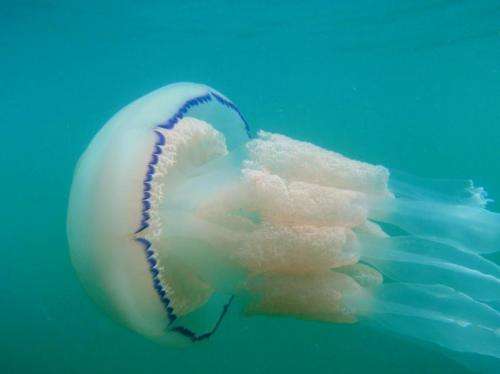August 6, 2014 weblog
Jellyfish food-finding strategy found to be more complex than thought

Predictive biologist Andrew Reynolds, with Rothamsted Research in the U.K. has found that barrel jellyfish (which live off the coast of U.K.) have developed a food-finding strategy that is far more sophisticated than scientists have thought. Indeed, as Reynolds explains in his paper published in Journal of the Royal Society Interface, its search techniques can be compared to the fast simulated annealing used by supercomputers to very quickly find solutions to unique problems.
In studying the barrel jelly, Reynolds discovered that it uses multiple strategies to find food, which is exclusively plankton—in large concentrations. Two of those strategies appear to be the most consequential. The first is based on a searching concept known as a Lévy walk—it's where a searcher searches in nearby areas for something, and then makes random jumps to more far away places if nothing is found locally. Failing that, another random jump will be made a farther distance away.
Scientists have found that other animals, including sharks, turtles and honeybees use the strategy to great effect because it results in quickly finding one of a number of possible suitable prey species. But because the barrel jelly is more discerning about its choice of meal, and amount it wants, it has developed another technique of finding prey—it moves suddenly to a higher or lower place in the water, notes if food is present, and if not, returns to its prior position. Scientists call this bouncing, and some have suggested it's merely a random tactic and likely not very effective. Reynolds disagrees, pointing out that it's a form of fast simulated annealing, and is very effective when used for finding a specific target among a mass of noise, very quickly—which is exactly why computer scientists use it with supercomputers that have been designed to look for the best possible solution among many, rather than a variety.
The combined strategies appear to work very well for the barrel jelly, it's the largest jelly in the area and manages to consume huge quantities of plankton on a regular basis—enough to sustain its needs. It's also unique because its techniques have never before been observed in any other animal.
More information: Signatures of active and passive optimized Lévy searching in jellyfish, Journal of the Royal Society Interface, Published 6 August 2014 DOI: 10.1098/rsif.2014.0665 . rsif.royalsocietypublishing.or … ntent/11/99/20140665
Abstract
Some of the strongest empirical support for Lévy search theory has come from telemetry data for the dive patterns of marine predators (sharks, bony fishes, sea turtles and penguins). The dive patterns of the unusually large jellyfish Rhizostoma octopus do, however, sit outside of current Lévy search theory which predicts that a single search strategy is optimal. When searching the water column, the movement patterns of these jellyfish change over time. Movement bouts can be approximated by a variety of Lévy and Brownian (exponential) walks. The adaptive value of this variation is not known. On some occasions movement pattern data are consistent with the jellyfish prospecting away from a preferred depth, not finding an improvement in conditions elsewhere and so returning to their original depth. This 'bounce' behaviour also sits outside of current Lévy walk search theory. Here, it is shown that the jellyfish movement patterns are consistent with their using optimized 'fast simulated annealing'—a novel kind of Lévy walk search pattern—to locate the maximum prey concentration in the water column and/or to locate the strongest of many olfactory trails emanating from more distant prey. Fast simulated annealing is a powerful stochastic search algorithm for locating a global maximum that is hidden among many poorer local maxima in a large search space. This new finding shows that the notion of active optimized Lévy walk searching is not limited to the search for randomly and sparsely distributed resources, as previously thought, but can be extended to embrace other scenarios, including that of the jellyfish R. octopus. In the presence of convective currents, it could become energetically favourable to search the water column by riding the convective currents. Here, it is shown that these passive movements can be represented accurately by Lévy walks of the type occasionally seen in R. octopus. This result vividly illustrates that Lévy walks are not necessarily the result of selection pressures for advantageous searching behaviour but can instead arise freely and naturally from simple processes. It also shows that the family of Lévy walkers is vastly larger than previously thought and includes spores, pollens, seeds and minute wingless arthropods that on warm days disperse passively within the atmospheric boundary layer.
Journal information: Journal of the Royal Society Interface
© 2014 Phys.org




















